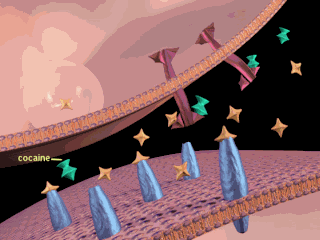Search inside of Supercourse and lectures in HTML and PPT format
 |
 |
front |1 |2 |3 |4 |5 |6 |7 |8 |9 |10 |11 |12 |13 |14 |15 |16 |17 |18 |19 |20 |21 |22 |23 |24 |25 |26 |27 |28 |29 |30 |review |
 But what happens when a person takes a drug? This slide shows how cocaine is able to alter activity in the synapse. Cocaine, shown in green, attaches to dopamine transporters (purple), preventing dopamine from being taken back up by the first neuron. This means dopamine remains in the synapse for a longer period of time, where it can continue to stimulate the receptors of the second neuron. This duration and amount of dopamine in the synapse is far greater than what normally occurs when a person engages in an enjoyable activity, and is what produces cocaine’s euphoria and the accompanying risk for abuse. |